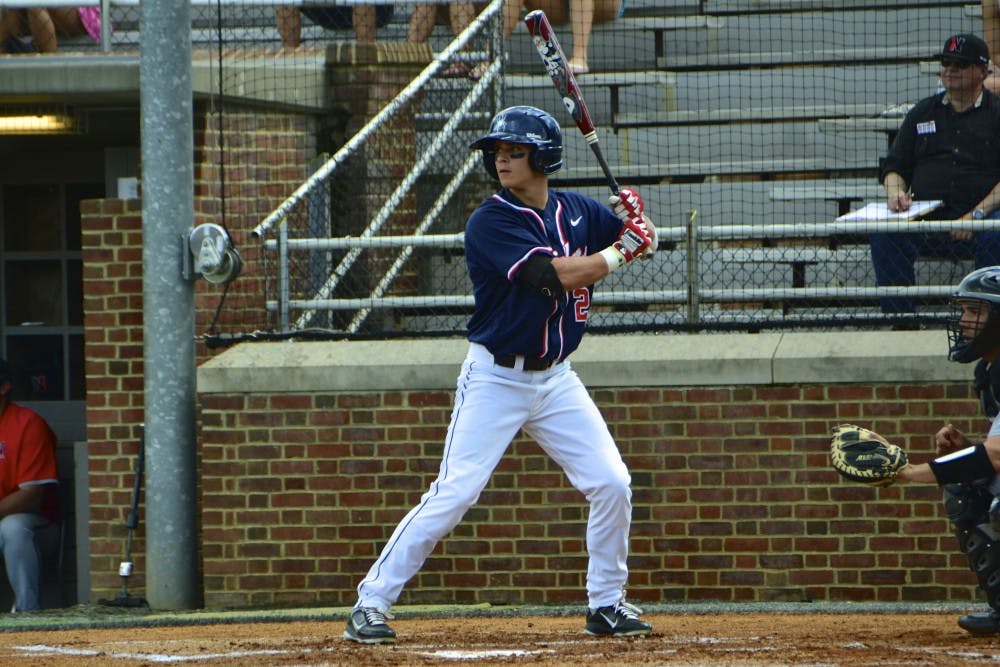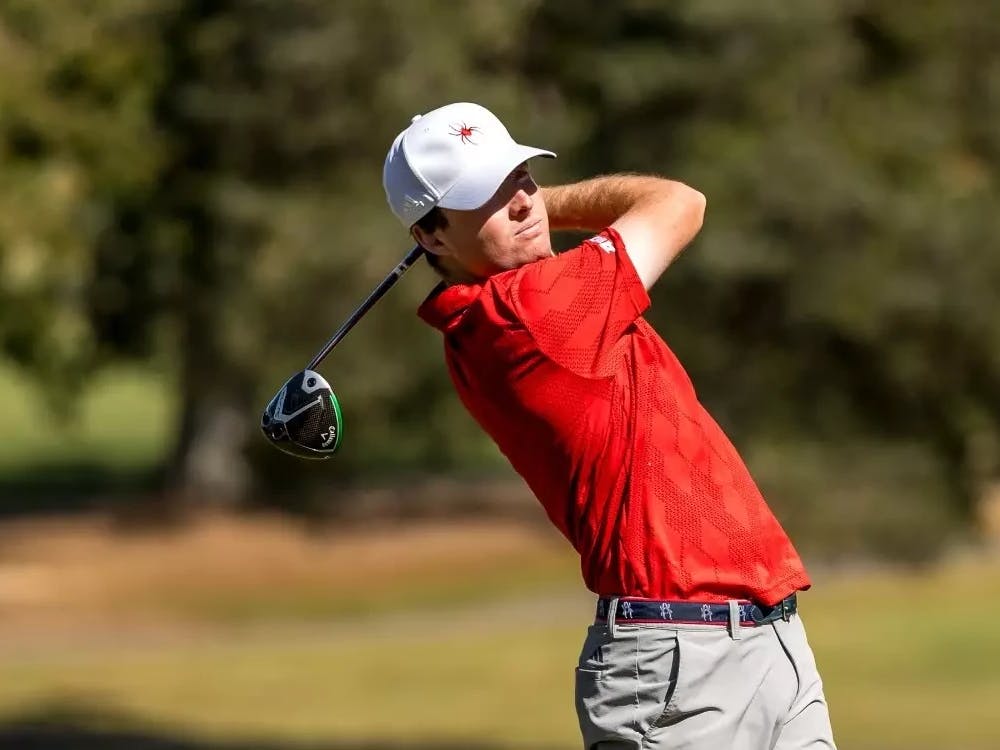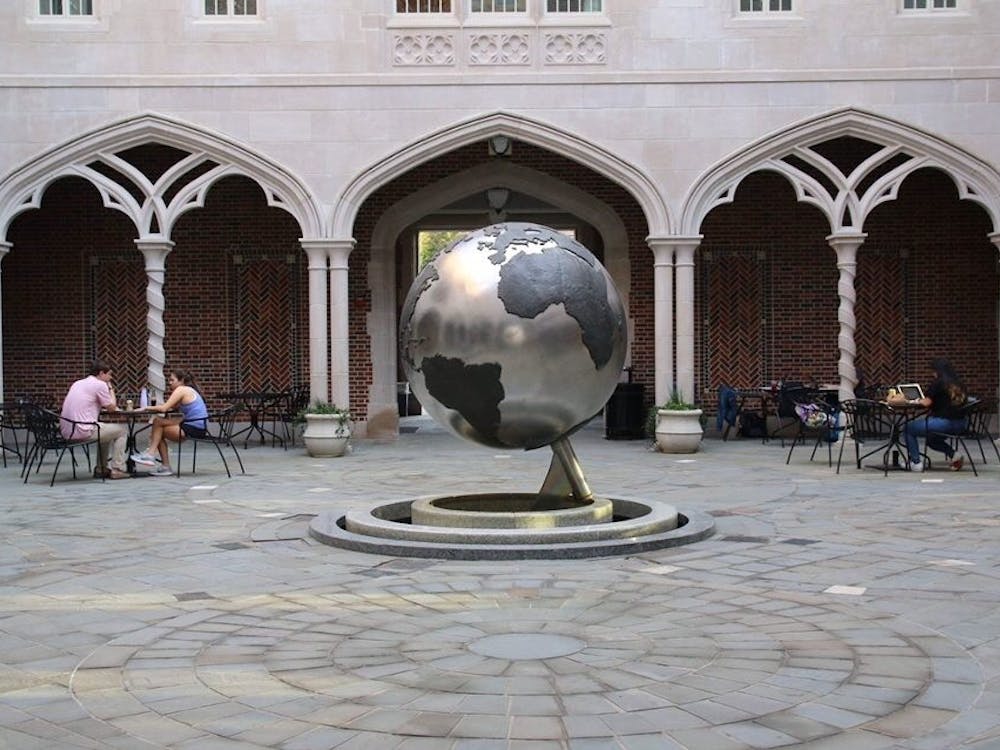On a brisk, October morning, 31 University of Richmond baseball players congregated on the frosty outfield grass of Pitt Field, huddling into a tangle of wind-milling arms and high-kicking legs as they warmed up for practice. After completing their stretches, the players jogged back to the dugout. Except one.
Tanner Stanley lagged behind, walking instead of running with his team.
It wasn’t a display of lesser dedication, but a nagging foot injury that held Stanley back. On any other day, he would likely be leading the pack.
As the players funneled into the dugout, gearing up to begin batting practice, the presence of a lone spectator sitting on the aluminum bleachers in a blue, hooded sweatshirt was observed in hushed tones.
“The first day I decide to shut it down, and there’s a Royals scout in the stands,” Stanley said, shaking his head in disbelief and slight amusement at the unfortunate timing as his signature grin slides across his face.
Stanley, team co-captain for the second year in a row, was a statistical leader his freshman and sophomore seasons. Going into his junior year, the first-year college players become eligible for the Major League Baseball Rule 4 Draft, much is expected from him, which is why on Oct. 25 he made the decision to shut down his foot for the remainder of the fall. He would not hit, run the bases or patrol centerfield for the majority of the team’s first-semester preparation time.
Son of Mike Stanley, who played for the Rangers, Yankees, Red Sox, Blue Jays and Athletics over a 15-year career, Tanner has the bloodlines of a big leaguer with the performance to prove it. In his explosive freshman season in 2013, he hit .308 with 17 doubles, three triples and one home run, which earned him the A-10 Rookie of the Year award, among other accolades. He scoffed at the idea of a sophomore slump in 2014 and hit for a .296/.408/.491 slash line, a baseball measurement that shows the key statistics batting average, on-base percentage and slugging percentage.
Another stellar season should earn him a spot on some team’s draft board, but he is starting out 2015 at a disadvantage. As the scout’s video camera peaked over the visitors’ dugout during the inter-squad game later in practice, the only footage it would have recorded of Stanley would be his playfully coaching third base with his mega-watt smile glinting in the sunlight, begging for a TV deal that would make ladies swoon like CJ Wilson in a Head & Shoulders commercial.
Stanley knows the scouts who visit in the fall are just checking in and trying to learn the names of players who might not yet be on their radar. Spring is the scouting season that really counts, and these scouts already know Tanner Stanley’s name. The scout and others like him will likely return in the spring to see Stanley in action. The looming question is: Will he be ready?
THE INJURY
When Stanley trotted out to centerfield for the bottom half of the first inning at Saint Joe’s University last May, he was feeling positive about the game’s potential after smacking a hit in the top half. With a runner on second base, a Saint Joe’s hitter lofted a routine fly ball to the outfield. Stanley snagged it, but when he got set to throw the advancing runner out at third, he heard a crunch so startling he dropped the baseball.
“The game just stopped, and Tanner is out there on the turf in centerfield screaming that he broke his foot,” third baseman Matt Dacey said. “You could feel your heart drop into your stomach.”
Enjoy what you're reading?
Signup for our newsletter
Stanley often goes home with scratches on his arms from making diving plays even on the rocky warning track. Observing his extreme dedication daily made helplessly watching Stanley yell in agony that much harder on Dacey and his teammates. “I think if you took baseball away from Tanner, that would be the biggest tragedy of his life,” head coach Tracy Woodson said.
After tossing the ball in to second base, Stanley tried to take a step forward but crumbled onto the ground. His teammates gathered around him and an athletic trainer ran out to identify the apparent injury. “She pressed on the outside part and I yelled as loud as I could,” Stanley said. “That’s when I knew it was bad.” He was carried off the field, and doctors later diagnosed a Jones fracture in his left foot.
Jones fractures occur in the fifth metatarsal – the long bone that connects to the pinky toe – and are relatively common injuries for athletes, said Will Heim, University of Richmond athletic training intern, who has treated multiple Jones fractures in his six years practicing athletic training.
Heim accompanied Stanley to the majority of his appointments with Dr. Mark Jones, and has overseen his recovery process from the two surgeries he underwent. Even with a screw drilled into the side of Stanley’s foot, doctor, trainer and player were all optimistic about his chances to make a full recovery. “He’s one of the best athletes I’ve worked with, treatment-wise,” Heim said. “He’s a hard worker, which motivates him to do everything right and to take care of his body. He’s on the right track, so he’ll be fine.”
The eight months Stanley has been affected by this injury has been the only time in his baseball career he has been sidelined for a significant duration. Through his first two collegiate seasons he had started 97 consecutive games, the highest running total among his teammates. Stanley’s meticulous care for his body and his passion for baseball are funneled into one goal: becoming a professional.
INFLUENCES FROM THE PROS
Down the hall from the Red Sox clubhouse is a room with red and white striped walls where Stanley spent his childhood evenings watching the Lion King on one TV screen and the live game taking place outside on another. Nine-year-old Stanley would play catch with his dad at Fenway and practice “robbing” home runs over the short end of the outfield wall. His exposure to major league culture ingrained in him a desire to play professionally for as long as he could remember.
“I never wanted to be an astronaut,” Stanley said. “[Playing baseball has] always been Plan A from the beginning. Nobody ever asks me what do you want to do with your life? They just know.”
As major league teams begin to show interest in him by sending him questionnaires to fill out for scouts to review, Stanley’s teammates and coaches are not surprised to see him moving closer to getting his dream job. They unanimously consider him one of the most physically talented members of Richmond’s team, and the affect his major-league exposure has had on his knowledge of the game is evident through the level of respect his teammates have for him.
“He’s such a cerebral player. He sees things that most people don’t see, and there’s a part of his game that you can’t really quantify,” Cook said. “He does everything the right way, the way you want to do it.”
“He grew up in a big league clubhouse, watching baseball,” Woodson said. “Nowadays with so many kids playing video games and not paying attention to what’s on TV to learn, that’s why some guys are behind. He’s not.”
Having a former major league player as his coach from Little League through high school has also contributed to Stanley’s edge. Key differences in their size and dominant hand – Mike Stanley was slightly larger than Tanner’s 5-foot-11-inch, 190-pound frame and is right-handed while Tanner is a lefty – prevented Mike from grooming Tanner into a younger version of himself, but their shared passion for baseball created a partnership that has grown stronger with every practice and game. “One thing I knew for sure was that he had a love for the game, so I wanted to make sure that I passed on to him all that I had learned and experienced in my career,” Mike said.
Tanner names his dad as his favorite baseball player and biggest role model, as well as his staunchest supporter. Occasionally he feels pressure about making it to The Show, but not from his dad. He is the one helping him cope with the pressure. “I've tried to let him know that I want him to work as hard as he can to make Tanner Stanley the best player he can be without worrying about the player Mike Stanley was,” Mike said. “We are different players. Shoot, there are attributes to his game that I wished I would have had in my own.”
With his major-league pedigree and training, the odds seem to be in Tanner’s favor to be drafted this summer, as long as he is able to make a full recovery from his foot injury. Any lingering effects could be detrimental if scouts who visit in the beginning of the spring season don’t return to see him playing at full health and therefore lower his status as a prospect. “I can’t see him not getting drafted,” Woodson said. “It’s just a matter of where he gets drafted, and then what does he want to do?”
Though Stanley missed the majority of the fall season and spring conditioning, he said he felt confident that he would be in full health by opening day and that his junior season would be just as strong as has been expected. It’s too soon to tell if he will get drafted or how high, but Stanley is certainly going to do everything in his power to make it happen. “I want to go. I want to get drafted and start my professional career,” Stanley said. “I’m ready.”
Support independent student media
You can make a tax-deductible donation by clicking the button below, which takes you to our secure PayPal account. The page is set up to receive contributions in whatever amount you designate. We look forward to using the money we raise to further our mission of providing honest and accurate information to students, faculty, staff, alumni and others in the general public.
Donate Now



